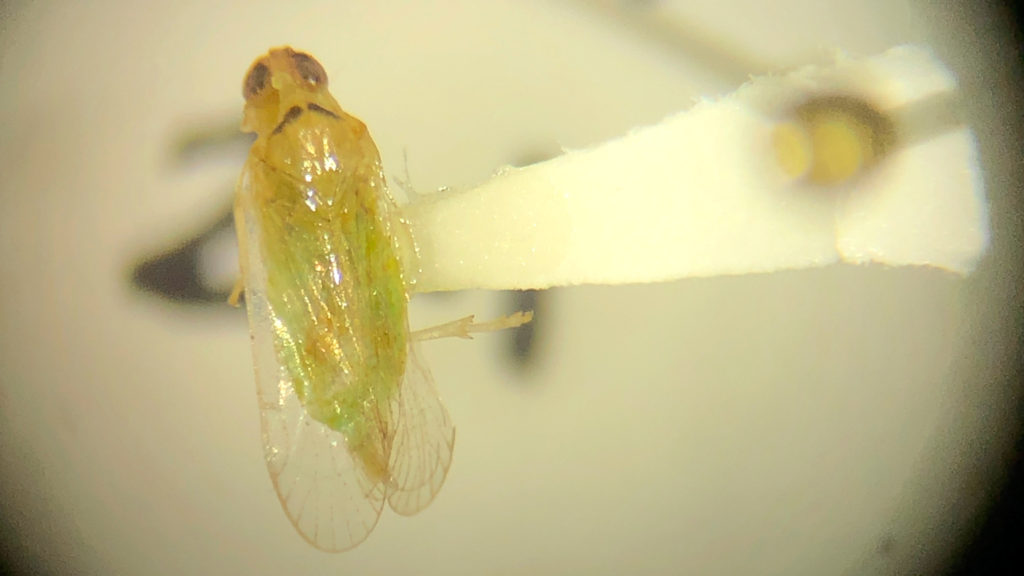Florida’s Iconic Palm Trees Threatened by Invasive Disease
Terry SpencerAugust 22, 2019

In this July 31, 2019, photo, a plant-hopper insect, that is thought to transmit a lethal bronzing disease to palm trees, is viewed through a microscope at a lab in Davie, Fla. Florida’s iconic palm trees are under attack from a fatal disease that turns them to dried crisps within months with no chance for recovery once ill. Lethal bronzing is caused by a bacteria spread by a rice-sized insect. It has gone from a small infestation on Florida’s Gulf Coast to a statewide problem in a decade. (AP Photo/Wilfredo Lee)
Florida’s iconic palm trees are under attack from a fatal disease that turns them to dried crisps in months, with no chance for recovery once they become ill.
The disease has spread to Miami-Dade County, and inspections are set for Crandon Park on Key Biscayne next week, county parks officials said.
Spread by a rice-sized, plant-hopping insect, lethal bronzing has gone from a small infestation on Florida’s Gulf Coast to a nearly statewide problem in just over a decade. Tens of thousands of palm trees have died from the bacterial disease, and the pace of its spread is increasing, adding to environmental woes of a state already struggling to save its other arboreal icon, citrus trees, from two other diseases.
Florida’s official state tree — the tall, broad-leafed sabal palm — is especially susceptible and Florida nurseries, businesses and homeowners are taking a financial hit as they scrap infected palms. Some preventive measures can be taken, but once infected, uprooting the tree is the only practical solution.
In Miami, lethal bronzing has been spotted in trees near Marlins park and along some highways, said Henry Mayer, a horticulture agent working with the University of Florida and the county parks department.
“It’s invasive, it’s difficult to manage. It’s not good news, that’s for sure,” Mayer said. He plans to inspect trees at area parks next week.
“Getting this disease under control is essential because it has the potential to drastically modify our landscape,” said Brian Bahder, an entomologist who studies insect-borne plant diseases and is a leader in the state’s battle against lethal bronzing.
If nothing is done, Bahder said, “I don’t think all the palm trees will die, but the issue we see will get a lot worse before it gets better.”
Lethal bronzing, which experts say likely originated in Mexico, also is found in parts of Texas and throughout the Caribbean. Some worry it will migrate to California and Arizona, infecting date palms and damaging that fruit crop. The disease has already heavily damaged Jamaica’s coconut plantations, and Brazil is taking preventive measures to avoid invasion.
Lethal bronzing’s first Florida appearance came near Tampa in 2006, but it’s now found from the Keys in the south to Jacksonville in the north. The disease is transmitted solely by the haplaxius crudus, a tiny winged insect sometimes called the American palm cixiid or, generically, a treehopper. These specific treehoppers (there are other kinds) inject the bacteria through their saliva when feasting on the sap from a palm’s leaves. Any palm cixiid that later feeds from the tree will pick up the infection and pass the bacteria to more palms.
Once inside a tree, the bacteria migrate to its base, multiplying until they clog the circulatory system — much like human arteries getting blocked by fat and cholesterol. The blockage makes it impossible for the tree’s cells to get sufficient nutrients and sugars, starving them. As an infected tree dies, its fronds and central spear leaf transform from green to a tell-tale shade of bronze as it succumbs in about six months. The disease doesn’t infect humans or animals.
Genetic testing shows lethal bronzing likely originated in Mexico’s Yucatan region. Bahder’s hypothesis is that 2005’s Hurricane Wilma, which tracked from the Yucatan to Florida, or a storm with a similar path carried infected treehoppers across the gulf to Tampa.
To check the spread, the state agriculture department regularly inspects palm nurseries and certifies those found free of the disease. If infected trees are discovered, they’re destroyed and the nursery’s remaining trees are quarantined for at least six weeks. Calls to about a dozen palm tree farms around the state weren’t returned — Bahder said it is a problem owners don’t like to discuss publicly, fearing it will hurt business.
Brent Gaffney, a Gainesville landscaper, said Bahder’s research is the state’s best hope for containing the disease, but only if he gets enough funding. Studies are underway on whether massive doses of antibiotics can save trees in the infection’s early stages.
After infected trees are removed, nearby palms need preventive antibiotic injections to halt the spread. Each injection costs $50 and loses effectiveness after three months: that makes injections before the disease is present too costly for most homeowners, businesses and municipal governments, Bahder said. Only high-end resorts that use mature palms to enhance ambience might consider injecting trees without a nearby infection, he said.
Lethal bronzing is sometimes called “Texas Phoenix palm decline” because it appeared in that state in the late 1970s, killing trees in the Rio Grande Valley around Brownsville. That state’s agriculture department says outbreaks today are infrequent and isolated. But Bahder said global warming is widening the threat.
“With increased human movement around the region and, especially, stronger weather patterns in regards to climate change, there are more possible routes for invasive insects,” Bahder said.
Key News’ Tony Winton contributed to this report.


